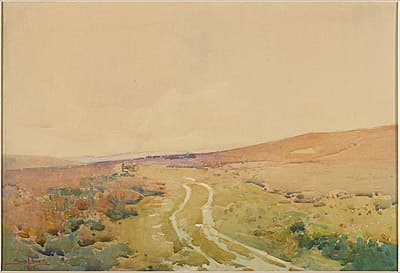
Sydney
LONG
Australia
1871
–
London
1955
England, Europe 1910-21; Australia 1921- 22; England 1922-25; Australia 1925-52; England from 1952
25.0 (h) x 27.0 (w) cm
signed and dated ‘SID LONG/ 1915’ lower left private collection
When Long visited Dartmoor in Devon in January 1911 he found the moorland ‘wild and lonely enough’ and without trees, ‘only heather and bare hills’. In winter it was a dead brown, unless it was white from frost or snow. Although he painted this watercolour several years later, it expresses his response to ‘the wildest scenery’ and ‘a country covered with hedged fences and traversed with little lanes sunk in the earth like burrows’ (Long, 9 February 1911).
Long said that when he was in Devon he was unable to paint, the weather was too
uncertain for any continuous work, and all he was able to produce was a mass of little colourless pencil sketches and a lot of photographs. It is possible he made this watercolour some time later, by referring to these drawings and photographs. Alternatively, he may have painted a scene on the Yorkshire moors.
Whatever the specific location, as with many of Long’s works, in creating this image he was not so much concerned with depicting a specific geographic place as in evoking an emotional response to an aspect of nature, to a bleak heath landscape and a lonely road winding through it.
When Long visited Dartmoor in Devon in January 1911 he found the moorland ‘wild and lonely enough’ and without trees, ‘only heather and bare hills’. In winter it was a dead brown, unless it was white from frost or snow. Although he painted this watercolour several years later, it expresses his response to ‘the wildest scenery’ and ‘a country covered with hedged fences and traversed with little lanes sunk in the earth like burrows’ (Long, 9 February 1911).
Long said that when he was in Devon he was unable to paint, the weather was too
uncertain for any continuous work, and all he was able to produce was a mass of little colourless pencil sketches and a lot of photographs. It is possible he made this watercolour some time later, by referring to these drawings and photographs. Alternatively, he may have painted a scene on the Yorkshire moors.
Whatever the specific location, as with many of Long’s works, in creating this image he was not so much concerned with depicting a specific geographic place as in evoking an emotional response to an aspect of nature, to a bleak heath landscape and a lonely road winding through it.
When Long visited Dartmoor in Devon in January 1911 he found the moorland ‘wild and lonely enough’ and without trees, ‘only heather and bare hills’. In winter it was a dead brown, unless it was white from frost or snow. Although he painted this watercolour several years later, it expresses his response to ‘the wildest scenery’ and ‘a country covered with hedged fences and traversed with little lanes sunk in the earth like burrows’ (Long, 9 February 1911).
Long said that when he was in Devon he was unable to paint, the weather was too
uncertain for any continuous work, and all he was able to produce was a mass of little colourless pencil sketches and a lot of photographs. It is possible he made this watercolour some time later, by referring to these drawings and photographs. Alternatively, he may have painted a scene on the Yorkshire moors.
Whatever the specific location, as with many of Long’s works, in creating this image he was not so much concerned with depicting a specific geographic place as in evoking an emotional response to an aspect of nature, to a bleak heath landscape and a lonely road winding through it.
